Commercial fish farmers are benefiting from floating fish feed that increases the maturity period and increases weight gain by over 60 percent.
According to Ugachick’s Operation Manager Susan Nakimu, the firm which for long has been known for poultry production in Uganda joined the fish sector to help in its commercialization. “As is the case in poultry production, feeds are an important component in fish farming as it constitute 60-70 per cent of operational costs. Therefore together with a team of researchers, we developed feeds that ensure the commercial viability of fish farming,” noted Nakimu. “The expertise and machinery were costly but got a grant from USAID’s Livelihood and Enterprise for Agricultural Development (LEAD) project to kick start the project,” she added.
Related News: Innovation sees Zambian farm become Africa’s leader in aquaculture
Related News: Farmer Beware: Why cheap homemade fish feed might be expensive
Naturally, Tilapia which is the commonly reared fish in ponds feeds on a wide range of tiny water plants and animals known as plankton. In ponds, plankton can be generated by fertilizing the water with either organic or inorganic fertilizers. However, when grazing, the amount of energy tilapia use to fend for these plankton in the pond is enormous. This coupled with the fact that the tilapia in the pond fight for limited plankton exerts pressure on them hence slow growth. “Under farmed conditions, there are more fish per unit area as compared to the wild and ultimately, while using fish ponds, it becomes impossible to provide the fish with appropriate levels of nutrition that can sustain economic growth rates hence the introduction of our floating fish feeds,” said Nakimu.
Ugachick’s floating fish feeds are tailored to meet the specific nutritional requirements of the fish at different stages of growth. She further noted that each pellet is complete in nutritional value and remains intact in water for about 15-20 minutes. “The trait of the fish pellet not dissolving immediately in the pond water and the ability for it not to sink reduces the potential negative effects on pond water quality which would have resulted from the excess feed decomposing in the pond as is the case with many other feeds available in the market.”
Related News: Approval of GM soymeal would reduce fish feed costs by 20%
She cautioned fish farmers to ensure that their ponds are free from any impurities and that the feeds introduced in the ponds are consumed and finished by the fish. She added, “One has to train the fish on their feeding schedule and this helps in their uniform growth and development and also cuts on resource wastages.” This mode of feeding fish is known as feed by response. The method emphasizes feeding based on the fish’s interest in coming to eat. Once the fish shows no interest in feeding, a farmer should not add more feeds in the ponds.
The floating fish pellets are best suited for commercial farmers based on their high feed conversion ratio. For farmers using this feed, they use about 1.5kgs of the feed to produce a tilapia weighing 1kg.
The company produces the feed using local ingredients including maize and soya beans.
